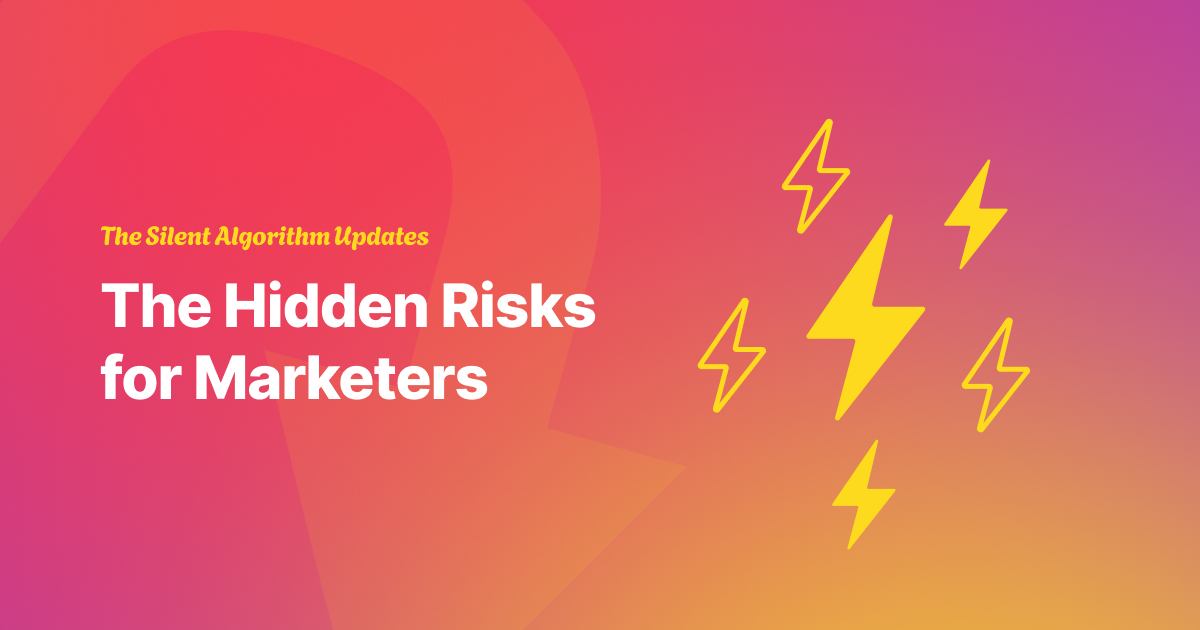The Silent Algorithm Updates: The Hidden Risks for Marketers
Introduction
One day, your marketing strategy is immaculate, your traffic is soaring, and your rankings are perfect. The next day, your visibility drops dramatically.
Not one word. No eye-catching “core update.”
Nothing but quiet.
Greetings from the world of quiet algorithm updates, the subtle, often unnoticed adjustments that can make or break your online reputation.
It is not a question of whether these stealth updates will occur.
The real question is how you’ll behave when they do.
Why It Matters
Algorithms are the unseen referees in the world of digital marketing. They decide which advertisements are displayed, which content ranks, and which brands gain popularity or go ignored.
Only a small percentage of the thousands of algorithm modifications made by Google each year are properly confirmed. Google promises to make over 5,000 enhancements each year, the bulk of which are unseen.
Smaller, invisible improvements designed to enhance the user experience are often the ones that cause the greatest disruption, despite our focus on significant upgrades such as Panda, Penguin, and Helpful Content.
Nonetheless, these tiny changes could mean the difference between your material being ranked as a top result and fading into digital obscurity.
What is a “Silent Algorithm Update”?
Consider a silent update as a slight change to the game’s rules.
Not made public (unlike big core updates).
Instead of making one-time modifications, consider making continual improvements.
focuses on subtle issues such as missing E-E-A-T signals, deceptive link patterns, and weak material.
An analogy would be if you were playing football and the referee suddenly declared that a slide tackle was forbidden, but no one informed you. Only when the red cards begin to pile up will you know it.
That’s how silent updates feel.
Before vs After (Simplified):
Before Silent Update → Thin, AI-generated, keyword-stuffed content could sneak onto page one.
After a Silent Update → Only high-quality, people-first content with trust signals keeps visibility.
Why This Matters Right Now
Silent algorithm improvements are shaping the SEO landscape in ways that go beyond theory.
Based on recent industry data:
- Without Google’s statement, Semrush volatility monitors reported unexplained increases in SERP fluctuations in March and July 2024.
- Similarweb data revealed significant losses in visits to health and retail websites, particularly those that employed scaled AI content.
- Google’s December 2024 spam update states that unannounced adjustments are now continuously reducing manipulative approaches, such as gateway pages and content exploitation on a large scale.
The message is clear: Google is penalizing shortcuts while increasing rewards for “helpful content.”
If you continue to favor volume over value, you are sitting on a ticking time bomb.
Actionable Insights: How to Survive Silent Updates
This three-part framework will help you future-proof your approach:
Step 1: Construct Your Own Media Stronghold
Your Website as Your Center → Give speed, technical SEO, and user experience top priority. Core Web Vitals are now required.
Your Lifeline: Your Email List → Your inbox is not controlled by algorithms. Get subscribers now.
Using First-Party Data as a Compass → Make decisions based on facts rather than conjecture by using tools like GA4 and HubSpot CRM.
Step 2: Transition to Topical Authority & Evergreen Content
Cornerstone Content → Write comprehensive manuals that address the main issues facing your audience.
Topical Clusters: Discuss a single topic from several perspectives. Connect. Give authority signals.
User Intent over Keywords → Pay attention to the reason behind the search (e.g., buying intent, problem-solving) rather than the exact words that are typed.
Step 3: Make Trust and Expertise a Priority
Use case studies, real research, and professional quotes to demonstrate, rather than just telling.
Author Credentials: Clearly explain the author’s skills (for example, Ismail Ayomide is a successful digital strategist).
Genuineness entails sharing personal experiences, mistakes, and insights acquired. Google and readers believe in people.
Examples & Case Studies
Case Study 1: The Failed Strategy
I offered consultancy services to a B2B SaaS company that relied on mass-producing templated blog content. Their goal was straightforward: create thin material, target specific keywords, and publish frequently.
They ranked for thousands of long-tail queries, which worked for a time.
However, there was a steady bleed by late 2024. A consistent daily decline of 1% to 2%. This is not a formal update. Not a warning.
What’s the truth? Google subtly updated its ranking signals to detect unoriginal content more effectively. Their house of cards fell apart.
Case Study 2: The Developed Approach.
A tiny content agency I mentor, on the other hand, has taken the opposite approach: one in-depth, expert-driven guide every month.Their most recent piece, “Building a Modern Website in 2025,” had professional interviews, original screenshots, over 5,000 words, and actionable recommendations.
When silent updates occurred, their ranks jumped from third to first place.
Why? Because Google’s quality-first policy was eventually matched by their advancements.
Not everyone is ruined by quiet updates.They reward those that create authoritative, helpful material, which aligns with Google’s long-term objectives.
Future Outlook: What’s Coming Next
The trend is evident.
Google is leveraging AI to uncover massive content misuse. Expect even more precise filtering.
Real-world signals will be more significant than technical ones. These include user interaction, backlinks from reliable websites, and references in credible publications.
Generative AI content will be subject to stricter review. Silent updates will bury your blog if it appears to be mass-produced.
The future victors will be brands that combine AI effectiveness with human understanding, originality, and authenticity.
Conclusion
Unnoticed algorithm changes aren’t hidden monsters. They are Google’s way of urging the industry to recommit to its core values: creating content that truly benefits people.
The winning brands will be those that create a reputation, demonstrate their competence, and consider the long term, rather than those that seek ways to circumvent restrictions.
Today’s Action Step: Review your ten best pages. “Is this content merely filling space, or does it actually solve my audience’s problem?” Make the necessary updates.
We would be delighted to assist you if you are ready to create an algorithm-proof content strategy and future-proof your marketing. Cooperate with us.
Or Continue learning: The Autonomous CMO

